Effective Applications of HR Analytics in Performance Optimization
Boost performance with HR analytics applications. Optimize workforce allocation and reduce turnover. Click to transform your HR strategy now!

Everyone says performance reviews are broken. And they are not wrong.
Outdated forms, vague goals, once-a-year feedback; none of it reflects how teams actually work today. While people collaborate across tools, time zones, and hybrid setups, traditional systems stay stuck in the past.
That is where HR analytics changes the game. Instead of relying on opinions or stale data, it gives people leaders live insight into what is really driving or dragging team performance. Think early signs of burnout, unseen high performers, and collaboration gaps that no spreadsheet can show.
For HRBPs, CHROs, and People Analytics leads in SaaS, fintech, and professional services, this is no longer optional. Whether you are trying to reduce attrition, coach managers, or grow sustainably, you need more than guesswork.
This blog unpacks how HR analytics can drive performance without creating more work for your already stretched HR teams. Let us start with what HR analytics really looks like in action.
TL;DR
- Traditional performance reviews fall short in today’s hybrid, fast-paced work culture
- HR analytics helps leaders make data-driven decisions on who is thriving, who needs support, and where to focus resources
- It goes beyond reports by offering predictive and prescriptive insights into employee performance
- Common applications include spotting high performers, preventing burnout, and improving OKR alignment
- Fast-scaling companies use analytics to rebalance workloads, identify upskilling needs, and address leadership bottlenecks
- Critical metrics include eNPS, time-to-productivity, internal mobility, and training ROI
- Barriers like siloed data, limited dashboards, and privacy concerns often block adoption
- HR analytics is most effective when insights are contextual, accessible, and integrated into daily decisions
What Is HR Analytics and Why It Matters for Performance
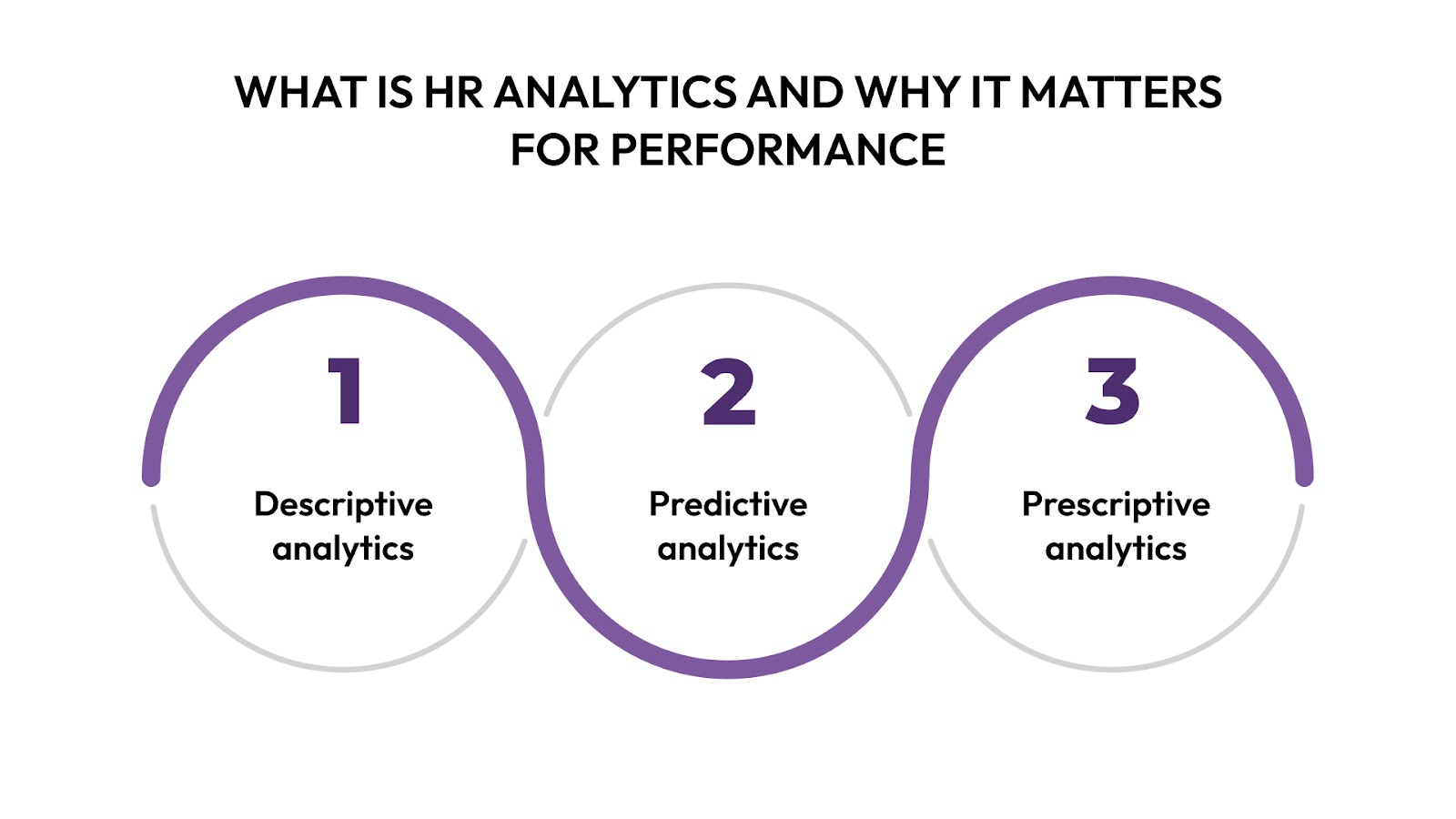
HR analytics refers to the use of data to make informed decisions about people, teams, and organizational performance. It goes beyond spreadsheets and surveys to show what is really happening inside your workforce.
There are three types of HR analytics, each playing a distinct role:
- Descriptive analytics shows what has already happened; such as past turnover rates or average performance ratings.
- Predictive analytics forecasts what is likely to happen; like who might be at risk of burnout or which teams may miss targets.
- Prescriptive analytics offers recommendations; such as which leadership training improves retention or how to restructure a team for better output.
In performance optimization, HR analytics brings clarity to everyday decisions. It helps leaders prioritize interventions, track the impact of coaching or policy changes, and build a culture that supports continuous improvement.
Core Applications of HR Analytics in Performance Optimization
HR analytics turns performance improvement into a measurable, repeatable process. This becomes even more critical in the U.S. where hybrid work laws, state-level compliance, and regional pay structures make performance management harder to centralize. Here’s how leading HR teams are applying it in day-to-day operations:
Identifying High Performers Early
By analyzing trends across KPIs, peer feedback, and project velocity, HR teams can spot rising stars even before formal reviews. This allows companies to fast-track growth paths and reduce the risk of losing top talent to competitors.
Detecting Underperformance and Burnout
Patterns in attendance, system logins, response time, and low engagement survey scores can flag early warning signs. HR leaders can intervene before performance dips impact team morale or client delivery.
Improving Goal-Setting and OKR Alignment
Analytics helps assess whether individual objectives align with broader team or business outcomes. If teams consistently miss goals, the data shows whether it’s due to misalignment, lack of clarity, or systemic blockers.
Optimizing Manager Effectiveness
Comparing team performance under different managers can surface leadership gaps. When paired with feedback sentiment or eNPS data, HR can identify where coaching or role adjustments are most needed.
Boosting Collaboration Across Teams
By connecting data from HR systems and collaboration tools, HRBPs can detect if certain departments are working in silos. This insight supports strategic cross-functional initiatives and smoother project execution.
Tracking L&D Impact
It’s not just about course completion rates. HR analytics can link training participation with productivity improvements, promotion cycles, or skill adoption across business units.
Designing Tailored Retention Plans
Using models that consider tenure, compensation history, manager effectiveness, and promotion velocity, HR teams can proactively identify flight risks and create retention plans specific to each persona.
Together, these applications help HR leaders move from reactive fixes to proactive performance design.
Want to see how performance data can uncover your next high performer or flag early burnout? Book a free demo with CandorIQ and explore real-time visibility across your teams.
How Fast-Scaling Companies Use Analytics to Support Performance
Growth creates pressure on both systems and people. Without timely insights, HR leaders risk overlooking performance blind spots. Here are common ways analytics is used to guide decisions during expansion:
Rebalancing Teams Based on Utilization Trends
As teams expand, workloads can skew unevenly. Companies use analytics to compare capacity, output, and engagement across teams. This often surfaces contributors carrying disproportionate weight, prompting support or redistribution of work before burnout occurs.
Prioritizing Upskilling Based on Real-Time Skills Data
Tracking the completion of technical certifications or training modules helps identify which teams are equipped for evolving project needs. If certain departments lag in emerging tools or compliance topics, leaders can course-correct through targeted learning.
Pinpointing Management Bottlenecks
Performance analytics often reveals where teams are consistently missing targets despite individual contributors performing well. This pattern can signal misalignment at the leadership level, prompting HR to step in with coaching, clearer OKRs, or role clarity efforts.
These insights don’t require guesswork; they emerge naturally when performance, collaboration, and engagement data are integrated into a unified system.
Scaling fast and need better visibility into what’s slowing your teams down? Schedule a demo with CandorIQ to see how data can support smarter org growth.
Metrics That Matter for Performance Driven Analytics
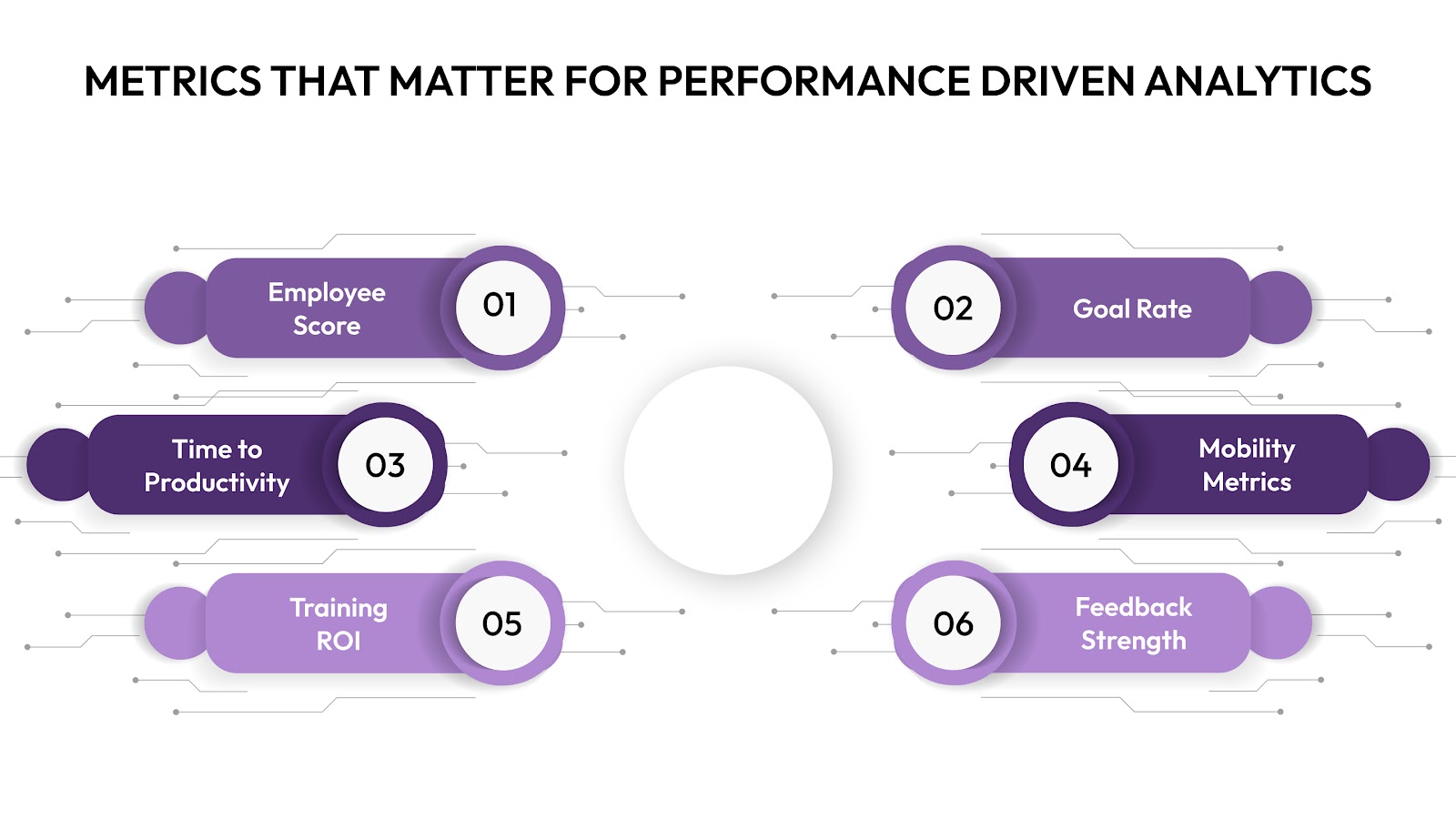
Tracking the right metrics helps HR teams go beyond gut feeling and ensure performance initiatives actually move the needle. These aren’t vanity numbers; they offer decision makers a clear lens into what's working, what's not, and where to act.
- Employee Net Promoter Score (eNPS): A simple yet powerful way to measure engagement and workplace advocacy. A dip in eNPS across specific cohorts can signal underlying cultural or managerial issues before they show up in turnover.
- Goal Completion Rate: Measures how consistently employees hit their objectives. When analyzed across teams, roles, or departments, this reveals alignment gaps between individual performance and company strategy.
- Time to Productivity: Especially important in fast growing environments. This metric captures how long it takes new hires to reach baseline contribution levels. Used well, it highlights onboarding effectiveness and team readiness.
- Internal Mobility Metrics: Tracks how often employees shift roles, teams, or functions. High internal movement often correlates with better retention and upskilling outcomes, particularly when mobility is tied to structured development plans.
- Training ROI: Goes beyond attendance. Look at how specific L&D investments contribute to productivity, promotion rates, or improved output. With analytics, HR can separate high impact training from checkbox learning.
- Feedback Loop Strength (Manager ↔ Team): Measured through the frequency and quality of feedback exchanged. A strong, two way loop is often tied to higher engagement and performance, especially in hybrid setups.
These metrics become even more valuable when viewed in context, across time, cohorts, and functions, enabling HR and People Analytics leaders to act with precision, not assumptions.
Barriers to Using HR Analytics Effectively
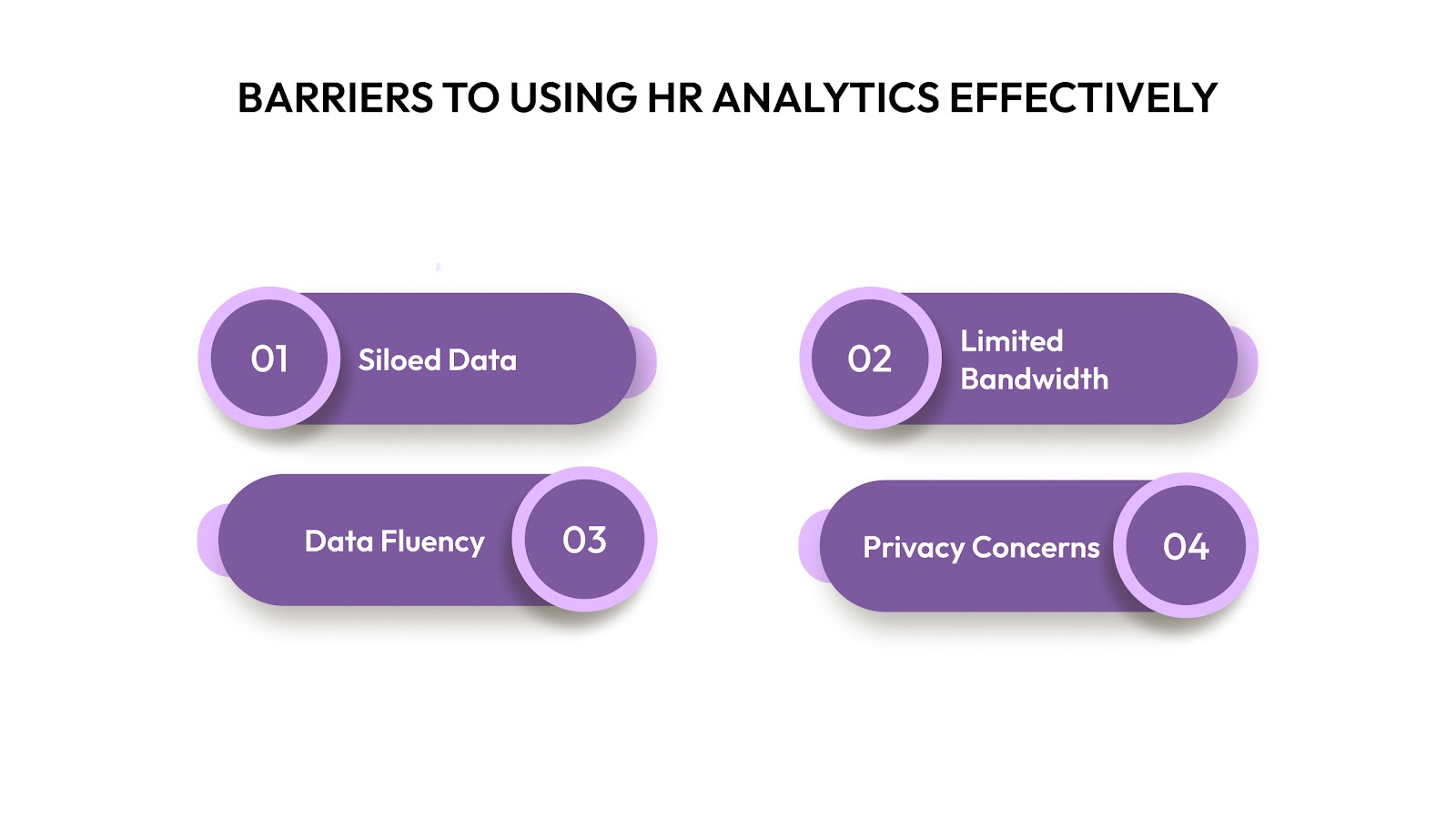
In US-based distributed teams, fragmented tools across time zones and states can slow down performance reviews and feedback loops. HR leaders know the value of data, but unlocking its full potential is rarely straightforward. Several common roadblocks prevent analytics from translating into action:
- Fragmented Systems and Siloed Data: Most growing companies rely on a stack of tools; HRIS, ATS, L&D platforms, engagement surveys. Without integration, it’s hard to get a unified view of the employee lifecycle or track performance trends end to end.
- Lack of Analyst Bandwidth and Real-Time Dashboards: Even when data exists, pulling reports and cleaning datasets manually delays insights. Without scalable, prebuilt dashboards, People Analytics teams spend more time gathering data than interpreting it.
- Limited Data Fluency Among Managers: Not all frontline leaders are comfortable using metrics to guide decisions. When analytics is presented without context or in overly technical terms, it becomes just another unused report.
- Concerns Around Privacy and Transparency: Especially in performance tracking, employees may be wary of how their data is being used. If trust and communication aren’t handled well, analytics can feel intrusive rather than supportive.
Addressing these barriers isn’t just a tech challenge; it requires thoughtful design, accessible tools, and alignment across HR, operations, and leadership. That’s where platforms like CandorIQ can turn complexity into clarity.
How CandorIQ Makes Performance Analytics Actionable
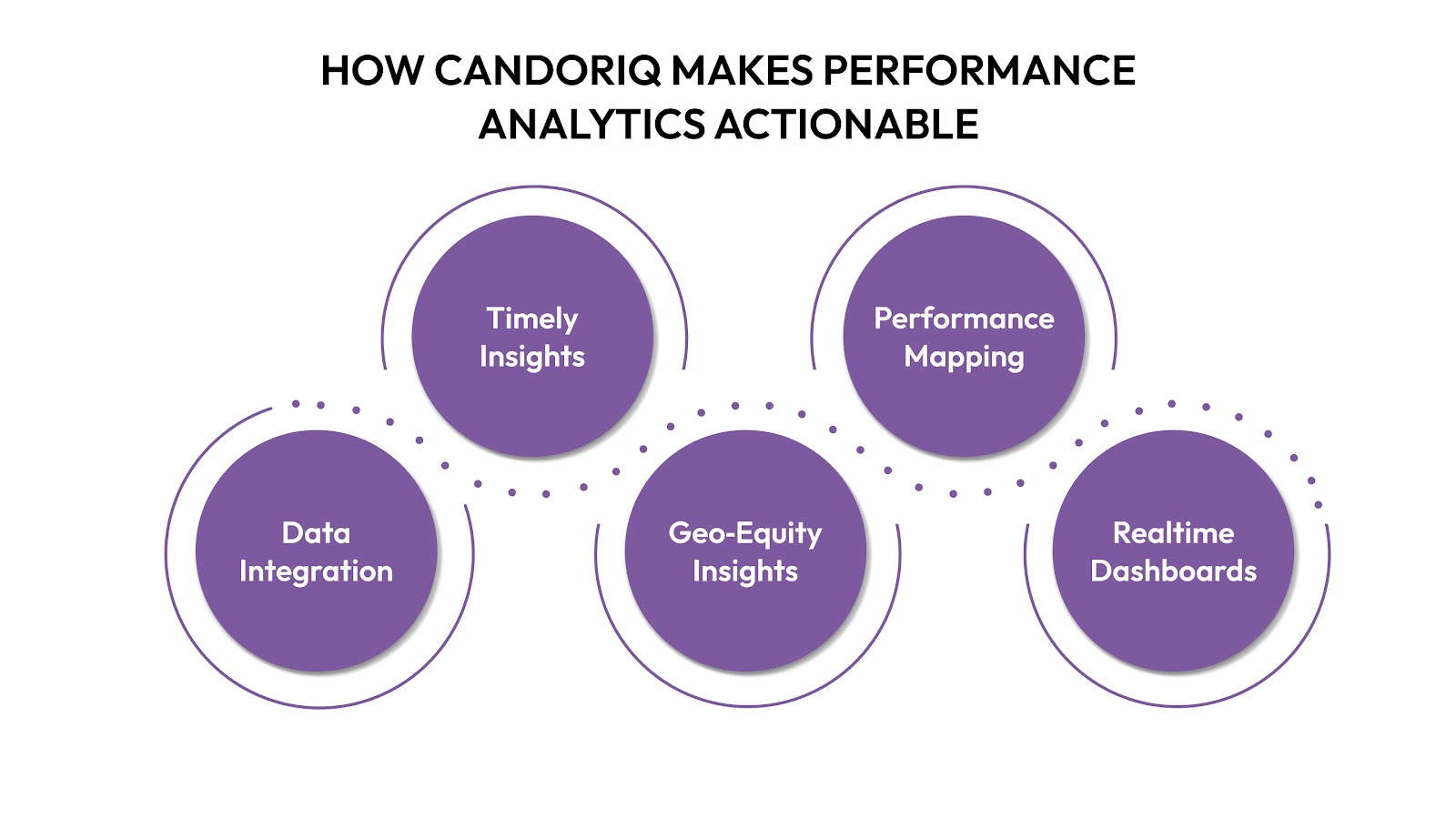
CandorIQ is built to help people leaders move from fragmented metrics to confident decisions. Instead of juggling disconnected dashboards or chasing manual reports, HRBPs and finance teams can access a unified, real-time view of workforce performance, all in one place.
Here’s how the platform turns performance analytics into everyday action:
- Brings Disconnected Data Together: CandorIQ integrates with your existing HRIS, performance tools, compensation systems, and collaboration platforms, eliminating silos and enabling clean, cross-functional reporting.
- Surfaces the Right Insight at the Right Time: From goal progress to team health trends, CandorIQ flags what needs attention, not just what’s available. Managers get digestible, prioritized takeaways instead of rows of raw data.
- Offers Geo-Level and DEI-Aware Analytics: Drill into performance by geography, department, tenure, or demographic group to ensure your strategies are equitable and locally effective.
- Maps Performance Directly to Compensation: See how bonuses, raises, and equity align with actual contribution, enabling reward strategies that are both fair and defensible.
- Puts Real-Time Dashboards in the Hands of Decision Makers: Whether you’re in HR, people ops, or finance, CandorIQ gives you the visibility to act fast, not wait for the next quarterly report.
With CandorIQ, performance analytics isn’t something you interpret later. It’s what guides your people's decisions today.
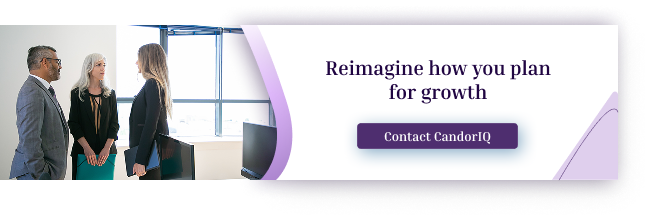
Ready to Make Performance Data Work Harder?
Performance optimization is no longer about gut feel or outdated review cycles. It’s about empowering HR, finance, and team leaders with the insights they need to guide decisions in real time. From surfacing high performers to spotting disengagement early, analytics can change how your organization grows, retains, and supports talent.
But insights only matter if they’re actionable.
CandorIQ brings all your performance, engagement, and compensation data together so you can act faster and smarter. With auto-surfaced insights, DEI-aligned views, and compensation-to-performance mapping, you get more than just numbers; you get clarity.
Want to see how it works in your own environment? Book a free demo with CandorIQ today.
Let your data lead the way.
FAQs
Q: What is the role of HR analytics in improving employee performance?
Ans: HR analytics helps identify performance trends, engagement gaps, and skill mismatches using data from multiple HR systems. This enables more targeted interventions, coaching, and recognition.
Q: How do I know which HR metrics are most important to track?
Ans: Focus on metrics that align with your business goals. Common ones include goal completion rates, employee net promoter score (eNPS), internal mobility, and time-to-productivity. Tools like CandorIQ can help surface these automatically.
Q: Can small and mid-sized companies benefit from HR analytics?
Ans: Yes. Even without large HR teams, AI-powered analytics tools can help smaller orgs identify retention risks, promote internal mobility, and improve manager effectiveness.
Q: How does HR analytics support DEI goals?
Ans: By breaking down performance, engagement, and promotion data by demographic segments, HR analytics can reveal systemic gaps and support more equitable talent decisions.
Q: What’s the difference between predictive and prescriptive HR analytics?
Ans: Predictive analytics forecasts future trends like turnover risk or burnout. Prescriptive analytics goes a step further by suggesting actions to take based on those predictions.
Q: How do HR analytics and compensation planning connect?
Ans: When performance data is linked to compensation decisions, organizations can create fairer, impact-driven reward systems. Platforms like CandorIQ map performance to pay in real time.
Q: What are the biggest challenges when starting with HR analytics?
Ans: Some of the most common hurdles include siloed data, lack of analytical expertise, and low adoption by managers. Choosing a platform that simplifies and visualizes insights can help bridge this gap.
Q: Are HR analytics tools like CandorIQ compliant with US data privacy laws?
Ans: Yes. CandorIQ supports best practices in data handling, security, and transparency. It’s designed to meet expectations around employee consent and compliance with regulations like CCPA.


